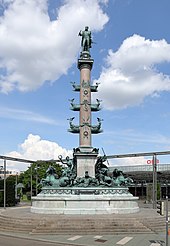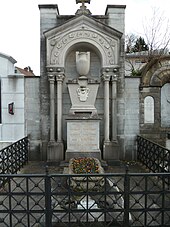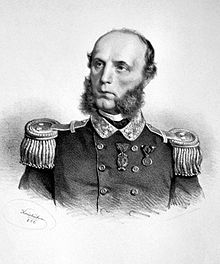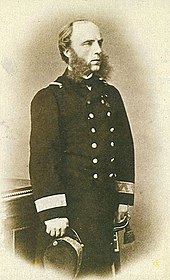Wilhelm von Tegetthoff
Wilhelm von Tegetthoff (born December 23, 1827 in Marburg an der Drau , Lower Styria , † April 7, 1871 in Vienna ) was Vice Admiral and Commander of the Austrian and Austro-Hungarian Navy .
Life
family
Wilhelm von Tegetthoff was born in 1827 as the son of the Imperial and Royal Lieutenant Colonel Franz Carl Gabriel von Tegetthoff and Leopoldine Czermak, daughter of the Fürstenberg district director Josef Czermak. The Tegetthoff family was ennobled by Maria Theresa in the 18th century , whose initials they also have in their coat of arms. On his mother's side, he was related to the mayor of Vienna, Baron Seiller .
Tegetthoff's ancestors came from Westphalia . This can be documented until the 17th century: Wilhelm Tegetthoff's great-grandfather, Johann Wilhelm Tegetthoff, born in Paderborn in 1701 , served in the imperial army. In the Seven Years' War as Rittmeister with the Esterházy Hussars , he was raised to the hereditary nobility on July 27, 1765 . He died in Eisenstadt in 1780 .
Of his five sons, the middle one, Josef, received the Knight's Cross of the Maria Theresa Order in the wars against France . His older brother Ignaz, the grandfather of Wilhelm von Tegetthoff, served as an officer in Infantry Regiment No. 47 and also took part in the wars against France. He retired in 1803 and died in Wieliczka , Galicia, in 1822 . His marriage to Josepha Böhm, a woman from Prague, had two sons and a daughter: Franz Wenzel and Franz Carl Gabriel and Sophie Frederike. Franz Carl Gabriel von Tegetthoff, the father of the admiral, joined the imperial army in 1805.
Education as a naval officer
Tegetthoff would have taken up a civilian profession, had it been up to his parents, but he was drawn to the sea and his father let him have his way. He attended the Austrian Naval College in Venice from 1840 to 1845 , where he was retired as a naval cadet. On July 23, 1845 he went on board a ship for the first time in regular service.
The revolution of 1848 and the changes that followed promoted Tegetthoff's rapid career. It took part in the blockade of Venice in 1848/49 and was then used on many journeys and expeditions of the Imperial Navy to the Levant and the so-called barbarian states .
First successes
In 1854 Tegetthoff was appointed commander of the war schooner "Elisabeth". At this time the ships, including the navy, were intensively converted to steam power . In 1855 he was given command of the paddle steamer Taurus , which was deployed in the Danube Delta , where the interests of Austria, Russia and the Ottoman Empire clashed with the growing self-confidence of the peoples who settled there. The young naval officer stood out there due to his excellent achievements in the diplomatic and organizational area.
1859/1860 he took from naval commander Archduke Ferdinand Max , brother of Emperor Franz Joseph I. , called on the journey of Archduke to Brazil in part. The further career went very apace: 1861 Tegetthoff became the battleship Captain (equivalent to the German Navy a sea captain in the army a Colonel ) transported. Associated with this was the command of the Austrian naval department in the Levant .
Sea battle near Heligoland 1864
In the German-Danish War , fought on the German side by Austria and Prussia , he fought against Denmark in 1864. In the sea battle near Heligoland (May 9, 1864) there was no winner. Both sides, the Danes and the Austrians, viewed the naval battle as a victory, despite considerable losses. On the day after the battle, Tegetthoff was promoted to the youngest Contreadmiral of the Imperial and Royal Navy at the age of 37 and was awarded the Order of the Iron Crown, 2nd class.
Victory at Lissa in 1866

His victory in the naval battle of Lissa on July 20, 1866 against the Italian fleet in the Third Italian War of Independence made him a naval hero. For his ramming tactics against the superior Italian fleet , he received the Commander's Cross of the Military Maria Theresa Order and was promoted to Vice Admiral. The fortress commander of Lissa , Colonel David Freiherr von Urs de Margina , who was very clever at keeping the Italians in check until the admiral could rush to his aid, played a major role in this victory .
From 1866 to 1867 he went on study trips to France , Great Britain and the United States . In the meantime, the imperial state was converted into a dual monarchy with the Austro-Hungarian Compromise in 1867. When Wilhelm von Tegetthoff returned from his study trips on July 3, 1867, Emperor Franz Joseph I personally commissioned him to bring home the body of his brother Maximilian, who was shot on June 19, 1867 in Mexico . Tegetthoff embarked on the SM frigate Novara , on which the future commander of the Austrian navy and Emperor of Mexico once began his career as a naval officer as a young archduke, in order to bring the remains of his great sponsor home. The vice-admiral was able to complete this delicate task to the complete satisfaction of the emperor. On February 25, 1868 he was appointed naval commander in chief and chief of the naval section.
Admiral and naval commander
From 1865 until his death Tegetthoff filled the function of a naval commander. Archduke Leopold , from 1865 naval troops and fleet inspector , was relieved of his post by Franz Joseph I on February 25, 1868. At the same time, the Kaiser appointed Vice Admiral Tegetthoff, succeeding Vice Admiral Ludwig von Fautz, as head of the naval section and thus deputy of the Reich Minister of War for naval affairs and at the same time as the new Commander Sr. Majesty of the Navy , thus combining all functions in his person. Due to the bundled authority - against the resistance of the General Staff - he was able to advance his reform projects regarding the Austrian Navy in a short time until his untimely death. His innovations remained in force until the defeat and the end of the dual monarchy in autumn 1918.
death
Tegetthoff had to go to a cure in St. Radegund near Graz in 1870 with health problems . He fell ill with pneumonia in 1871, from which he died in 1871. His grave is in the St. Leonhard Cemetery in Graz. He left his entire fortune to his brothers: the modest sum of 267 guilders and 40 kreuzers .
Honors

Vienna
- In 1866 in Vienna- Landstrasse (3rd district) the Lissagasse was named after the naval battle of Lissa.
- In 1877 the street in the inner city branching off from the Neuer Markt and leading to the corner of Albertinaplatz / Maysedergasse opposite the Palais Archduke Albrecht was given the name Tegetthoffstrasse .
- Since 1886, recalls Tegetthoff Monument of Carl Kundmann and Carl von Hasenauer at the Vienna Prater Stern at him
- In 1914, Helgolandgasse in the 20th district, Brigittenau , was named after the sea battle near Helgoland.
- In Vienna there is an entertainment ship of the DDSG Blue Danube under the name Admiral Tegetthoff .
- The former Tegetthoff naval barracks in the 19th district got his name.
Graz

- In his hometown Graz, the Mur bridge, which was completed in 1975, was named as an extension of Belgiergasse Tegetthoff bridge.
- There is a Lissagasse in the Graz district of Gries .
- In St. Radegund near Graz, the Tegetthoff stone erected in 1871 on the Polenfels is a reminder of his presence in 1870.
- The Villa Tegetthoff , in which he moved into accommodation in St. Radegund during his stay at the spa, bears his name; a marble plaque donated by the Tegetthoff-Graz Marine Comradeship in 1988 refers to him.
Pola, then Graz
In Pola in the Crown Land of Istria , the main war port of the Austro-Hungarian Navy, the monument for Tegetthoff , designed by Carl Kundmann and cast by the Austro-Hungarian Kunst-Erzgießerei in Vienna, was erected in 1877 with the inscription: “Brave fighting near Helgoland, gloriously victorious near Lissa he immortalized fame for himself and Austria's maritime power. ”After the collapse of the Habsburg monarchy , Pola came to Italy in 1918 , against which Tegetthoff had fought at sea. The memorial was therefore dismantled, stored in Venice and rebuilt in Graz St. Leonhard on Tegetthoffplatz in 1935 , two blocks into town from its final resting place.
The approximately 3.5 meter high and approximately 1.5 tons heavy bronze statue was removed from the pedestal at a height of 4 meters due to corrosion damage and stored for restoration in 2013. In the discussion about the reconstruction, the district council spoke out in favor of it. In cooperation with the Federal Monuments Office, the entire statue was to be restored in 2016 at a cost of € 250,000 . The renovated monument was erected again in autumn 2016.
More places
- The Tegetthoff monument by Heinrich Fuss in Marburg was unveiled in 1883 by Emperor Franz Joseph I. After the First World War, the monument was removed; the bust is now in the State Museum of Marburg.
- In Linz there is a Tegetthoffstraße near the main train station.
- In Dornbirn , in the Dornbirn-Hatlerdorf district, a street got his name.
Ships and geographical name
- The ship of the Austro-Hungarian polar expedition built for an expedition by Julius Payer and Karl Weyprecht , 1872–1874, was christened S / X Admiral Tegetthoff .
- The part of Hall Island that the expedition first saw in the archipelago in 1873 has since been called Cape Tegetthoff (Mys Tegetchof ).
- The largest and strongest class of capital armored ships of the kuk Kriegsmarine was called the Tegetthoff class (sometimes also Viribus Unitis class ) and comprised the four battleships SMS Viribus Unitis , SMS Prinz Eugen , SMS Szent Istvan and SMS Tegetthoff , built from 1910 .
- The heavy cruiser Prinz Eugen , built in 1938, was to be named after Tegetthoff, but it was feared that it would annoy allied Italy.
Museum reception
In the Army History Museum in Vienna, where the history of the Austrian Navy is documented in detail, there are several memorabilia and personal items from Tegetthoff. Numerous portraits are shown, including one by Georg Decker . Furthermore, Tegetthoff's saber , several photographs, his commander's cross of the Military Maria Theresa Order and a gift of honor from the city of Trieste in the form of a gold centerpiece are on display.
literature
- Jerolim Freiherr von Benko: Tegetthof, Wilhelm von . In: Allgemeine Deutsche Biographie (ADB). Volume 37, Duncker & Humblot, Leipzig 1894, pp. 530-535.
- Klaus Müller: Tegetthoff's March in the North Sea. Oeversee, Düppeler Schanzen, Heligoland in the German-Danish war. Verlag Styria, Graz 1991, ISBN 3-222-12007-2 .
- Christian Ortner : The sea war in the Adriatic 1866. In: Viribus Unitis. Annual report 2010 of the Army History Museum. Vienna 2011, ISBN 978-3-902551-19-1 , pp. 100–124.
- Ulrich Schöndorfer: Wilhelm von Tegetthoff. Berglandverlag, Vienna 1958.
- Peter Handel-Mazzetti, Hans Hugo Sokol: Wilhelm von Tegetthoff. A great Austrian, OÖ Landesverlag, Linz 1952.
- Chapter 7: Wilhelm von Tegetthoff. In: Wilhelm Wolfslast : Heroes of the Sea. Volume 1. Explorers and Admirals. Berlin 1944, pp. 102-117.
- Helmut Neuhold: Austria's heroes at sea . Styria Verlag Wien-Graz-Klagenfurt 2010, ISBN 978-3-222-13306-0 , pp. 108-139.
- Agnes Husslein (Ed.): Anton Romako. Tegetthoff in the sea battle near Lissa . Catalog for the exhibition in the Austrian Gallery Belvedere , Vienna 2010, ISBN 978-3-901508-79-0 .
- Igor Grdina: Wilhelm von Tegetthoff and the sea battle near Lissa from July 20, 1866. Translated from the Slovenian by Urška Črne and Hubert Bergmann. Maribor: Umetniški kabinet Primož Premzl, 2016, ISBN 978-961-6055-46-8 .
- Georg Pawlil: Tegetthoff and the sea battle before Helgoland, Verlag Österreich, 2000, ISBN 3-7046-1627-3 .
- Peter Steiner: Vice Admiral Wilhelm von Tegetthoff. Military biographical notes based on his medals and promotions. 2017 online on HGM Knowledge Blog
Web links
- Literature by and about Wilhelm von Tegetthoff in the catalog of the German National Library
Individual evidence
- ^ Antonio Schmidt-Brentano: The KK or KuK Generality 1816-1918. ( Memento of October 4, 2013 in the Internet Archive ) Austrian State Archives, Vienna 2007, p. 185 (PDF).
- ^ Antonio Schmidt-Brentano: The Austrian admirals. Volume 1: 1808-1895. Bibliotheksverlag, Osnabrück 1997, pp. 176-187.
- ^ Ulrich Schöndorfer: Wilhelm von Tegetthoff. Bergland Verlag, Vienna 1958.
- ^ Georg Pawlik: Tegetthoff and the sea battle off Heligoland. 2000, p. 25.
- ^ Georg Pawlik: Tegetthoff and the sea battle off Heligoland. 2000, p. 79.
- ^ Georg Pawlik: Tegetthoff and the sea battle off Heligoland. 2000, p. 81.
- ^ Herbert Wrigley Wilson: Ironclads in Action. 1896.
- ↑ Austria's hoard. Historical and cultural images from the Habsburg hereditary lands. A solemn offering to the Austrian people for the jubilee celebration of Emperor Franz Josef I. 1908. Published by a circle of patriotic writers. Patriotic Volksbuchhandlung, Vienna 1908, Volume 2, p. 449.
- ^ Georg Pawlik: Tegetthoff and the sea battle off Heligoland. 2000, p. 31.
- ↑ Official part. In: Wiener Zeitung. No. 55, Vienna, March 4, 1868, p. 1. (anno.onb.ac.at)
- ^ Paul Rohrer: When Venice was still Austrian - memory of two officers. Robert Lutz publishing house, Stuttgart 1913.
- ↑ Manfred Jasser: Up from the Dachstein. The Styria Breviary. Paul Neff Verlag, Vienna 1990, ISBN 3-7014-0131-4 , p. 64.
- ^ Harald D. Gröller: Wilhelm von Tegetthoff . In: Bernhard A. Reismann, Harald D. Gröller (Ed.): St. Radegund. A Styrian health resort and its history. tape 2 . Self-published, St. Radegund 2016, ISBN 978-3-200-04776-1 .
- ↑ K. k. Art foundry in the Vienna History Wiki of the City of Vienna
- ↑ Tegetthoff monument needs to be restored. Culture server Graz. (Kultur.graz.at , accessed December 22, 2015).
- ^ Re-erection of the Tegetthoff monument after renovation at the previous location . Proposals for the district council meeting, SPÖ Graz, September 16, 2014 (graz.spoe.at , accessed December 22, 2015).
- ↑ Current news from the city senate - Admiral Tegetthoff can be renewed. November 6, 2015 ( graz.at ( memento of December 23, 2015 in the Internet Archive ), accessed December 22, 2015).
- ^ Sculptor Prof. Heinrich Fuß. (On the occasion of the foot memorial exhibition in the Ferdinandeum.). In: Innsbrucker Nachrichten , April 3, 1914, pp. 1–3 (online at ANNO ).
- ^ Wilhelm von Tegetthoff - Monument. Maribor University Library, accessed on August 19, 2019.
- ↑ Army History Museum, Military History Institute (ed.): The Army History Museum in the Vienna Arsenal . Verlag Militaria , Vienna 2016, ISBN 978-3-902551-69-6 , p. 156.
| predecessor | Office | successor |
|---|---|---|
| Ludwig von Fautz |
Navy commander 1865–1871 |
Friedrich von Pöck |
| Ludwig von Fautz |
Chief of the Marine Section 1868–1871 |
Friedrich von Pöck |
| personal data | |
|---|---|
| SURNAME | Tegetthoff, Wilhelm von |
| BRIEF DESCRIPTION | Austrian admiral |
| DATE OF BIRTH | December 23, 1827 |
| PLACE OF BIRTH | Marburg on the Drau |
| DATE OF DEATH | April 7, 1871 |
| Place of death | Vienna |




